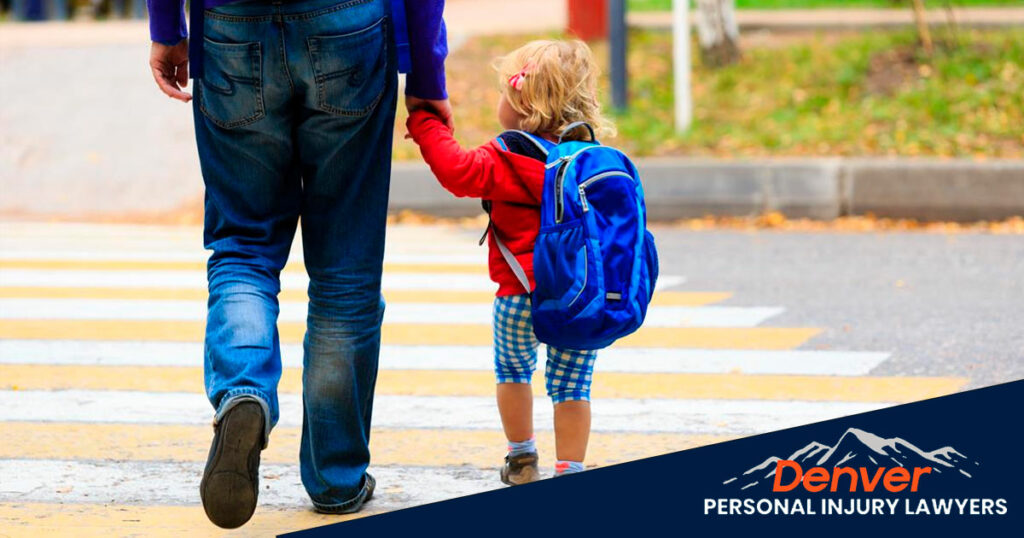While walking is a great, healthy activity for kids, it still poses a safety risk. We all want our children to enjoy a sense of independence and freedom, but we still want them to be safe.
Children are particularly vulnerable on or near roadways due to their lack of experience and different developmental levels. Especially during the summer months while school is out, children will be playing outside, walking to parks, or going to the local store. The downside to this is that all of the outdoor time puts children at greater risk for pedestrian accidents. Pedestrian accidents can result in severe and potentially fatal injuries.
Whether playing outside or walking to school, parents must teach children to practice safe pedestrian skills. In addition, it’s essential to give children opportunities for discussion and practicing real-life safety scenarios.
This article will go over some fundamental pedestrian safety guidelines for kids. It’s also important to know the cause of common accidents. Finally, as parents, it is our responsibility to know what we can do to keep our children stay safe on the sidewalks.
Table of Contents
ToggleHow You Can Help Protect Kids From Pedestrian Accidents
We’ve compiled some tips for teaching kids how to walk around the neighborhood independently and safely. Children must know these skills to lower the risk of being involved in a pedestrian accident. Here are some skills and information to share with your kids:
- Always take the safest route to walk. You should show your children the safest route to walk. The best course will be accessible, easily walkable, and well-lit.
- How to cross the street safely. Find the best place to cross so that you are as visible as possible to drivers. It’s not safe to assume that a marked crosswalk or stoplight is automatically safe. If there is a walk signal, be sure only to cross when you have the walk signal.
- Practice analyzing vehicle speed. Teach your children to assess the speed of a vehicle. Avoid the mistake of assuming that a car will make a complete stop. If a vehicle is passing, do not cross. Wait until the car makes a complete stop, and you are sure the driver can see you before crossing.
- Be very attentive while walking near roadways. Children must know that they should be alert of their surroundings while walking near cars. Avoid distractions like cell phones or electronic devices that could take attention away from what’s around you.
- Make sure drivers can see you. Teach your kids to be as visible as possible to vehicle operators. When a car stops, make sure that your child knows to make eye contact with the driver before crossing. That way, your child will know the driver actually saw them.
Pedestrian Injuries Involving Children
According to reports from the National Institutes of Health (NIH), “anyone can be a victim of pedestrian injuries, but children and teenagers are at greater risk.” In fact, the third leading cause of accidental death for children in the US under 18 is getting hit by a car. Car accidents are also one of the top causes of severe and life-changing injuries. Those statistics are alarming. The NIH suggests that children face different risks depending on their age group. Here are the risks by age group:
- Children under 4: young toddlers under four are most vulnerable to pedestrian injuries in driveways. Driveway backover accidents can involve parents, other family members, guests, or neighbors.
- Ages 4 to 12: adolescents and pre-teens between ages 4 to 12 are more likely to hit cars at crosswalks or while playing near a busy street. Children of this age group haven’t yet developed the cognitive abilities for speed perception. They may have a hard time understanding traffic patterns moving in multiple directions. Children ages 4-12 are also more likely to make impulsive decisions. As such, they could haphazardly bolt into traffic without first checking for oncoming cars.
- Ages 12-18: Teenagers are most susceptible to injuries while walking at night or in areas with poor visibility. Some factors that heighten this risk for teenagers include:
- Being under the influence of illegal substances
- Texting while walking or being otherwise distracted by cell phone use
Age-Appropriate Tips by Age Group
Since children go through specific stages of development, it’s important to teach them age-appropriate safety tips. Children of all ages should learn how to walk to and from their destination safely. Moreover, we adults need to teach them so that they understand. Here are some tips based on each of the age groups:
4 to 6 years old: For children under 6, it’s best to speak in simple terms about the basics of safety skills. It would be ideal for walking with them to have the experiential learning of safe walking. For children of this age group, it’s also a good practice to hold their hands. Young children can be impulsive and might run away unexpectedly if something catches their attention. Show them the best place to cross the street and how crosswalks work. Let your child push the button themselves at the crosswalk. Also, share how they can make themselves very visible to drivers on the road. Some good tools are reflective items and flashlights. Remember that young children should always be supervised while walking. The majority of all children pedestrian injuries happen while they are unaccompanied by an adult.
7 to 9 years old: kids in this age range will better grasp complex safety principles. Reinforce the basic safety tips and emphasize the safest way to cross the street. Teach your child to assess a car’s speed. More importantly, teach them to stop, listen and look before crossing the street. Children aged 7-9 should understand the significance of being visible to the drivers on the road. And again, young children should always be supervised by an adult when walking and practicing safety tips.
Over ten years old: Children will have developed reasoning skills, greater attentiveness, and better decision-making skills at this age. These are necessary skills for pedestrian safety. Depending on the child, they may be ready to practice independent walking at this age. It’s best not to pressure a child or assume they are ready. Always err on the side of caution and supervise your child until they are prepared to walk unsupervised. There’s no rush for children to grow up, and it’s always better to be safe than sorry.
Contact a Denver Pedestrian Accident Attorney for a Consultation
The work of children is to play. It’s our job as adults to equip them with the skills and knowledge for pedestrian safety. Our legal team is here to help if you or your child has been injured in a pedestrian accident.
Contact an experienced pedestrian accident attorney immediately for a free consultation. You need a good attorney to get the total compensation you deserve.
















